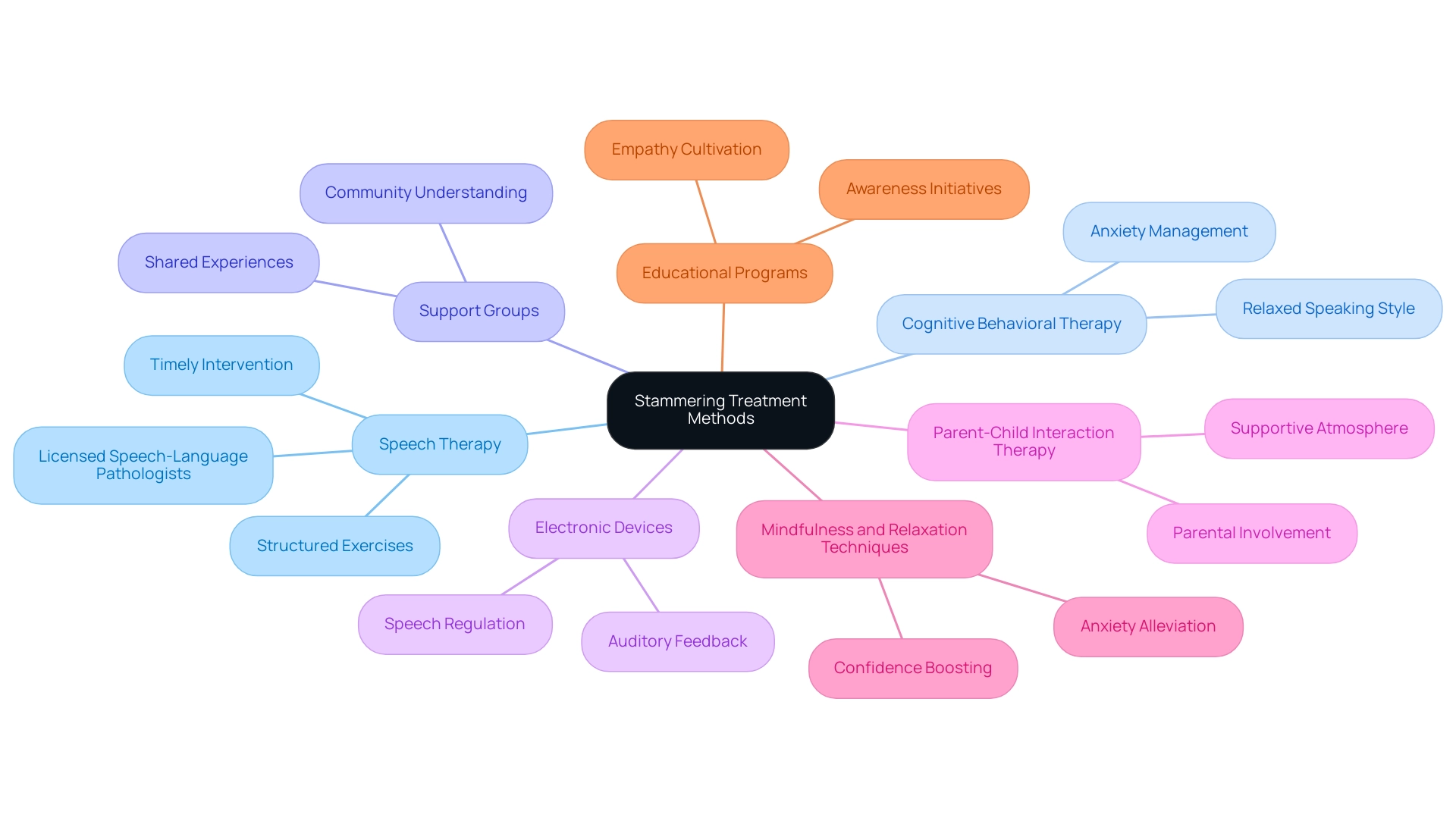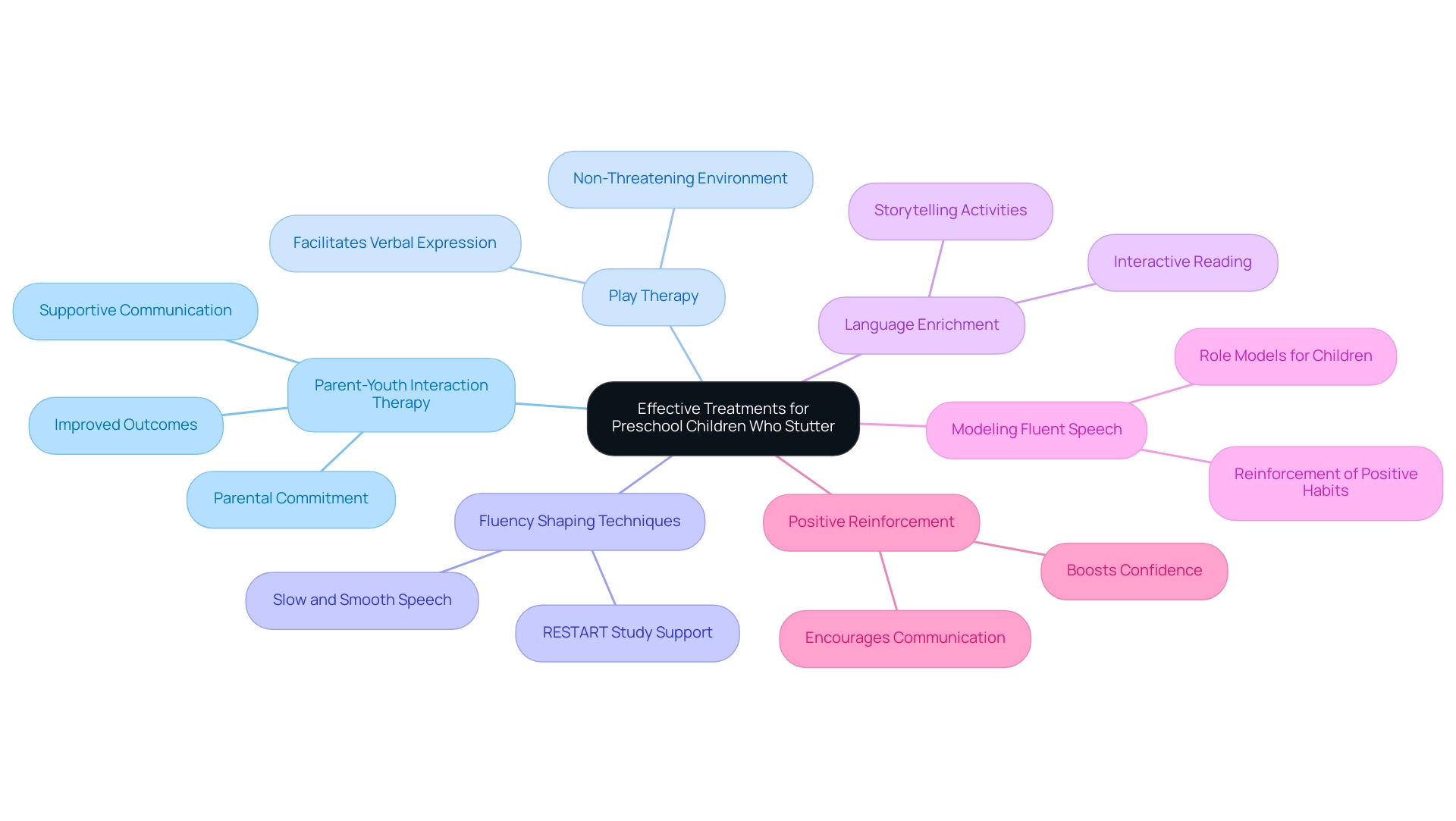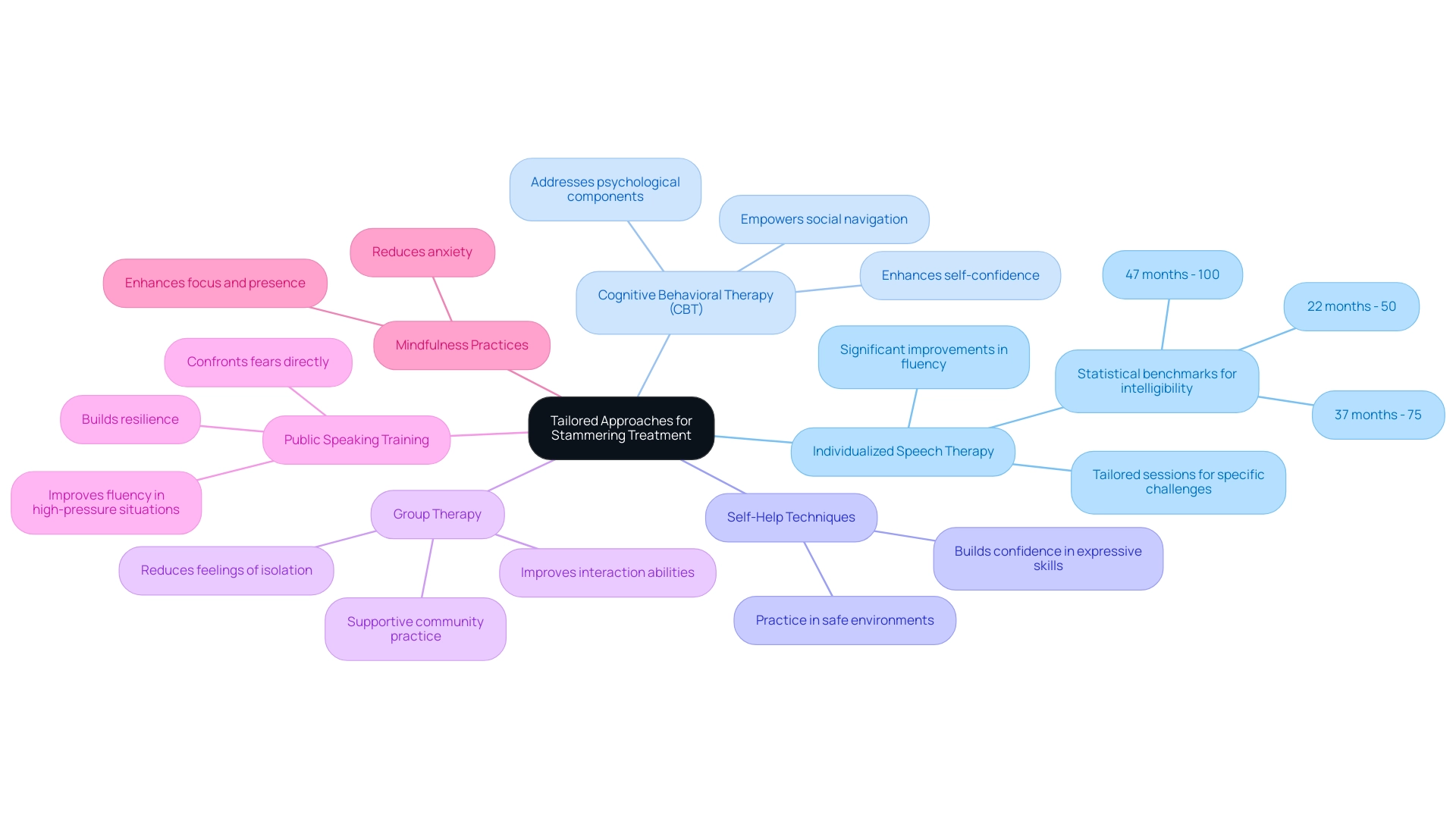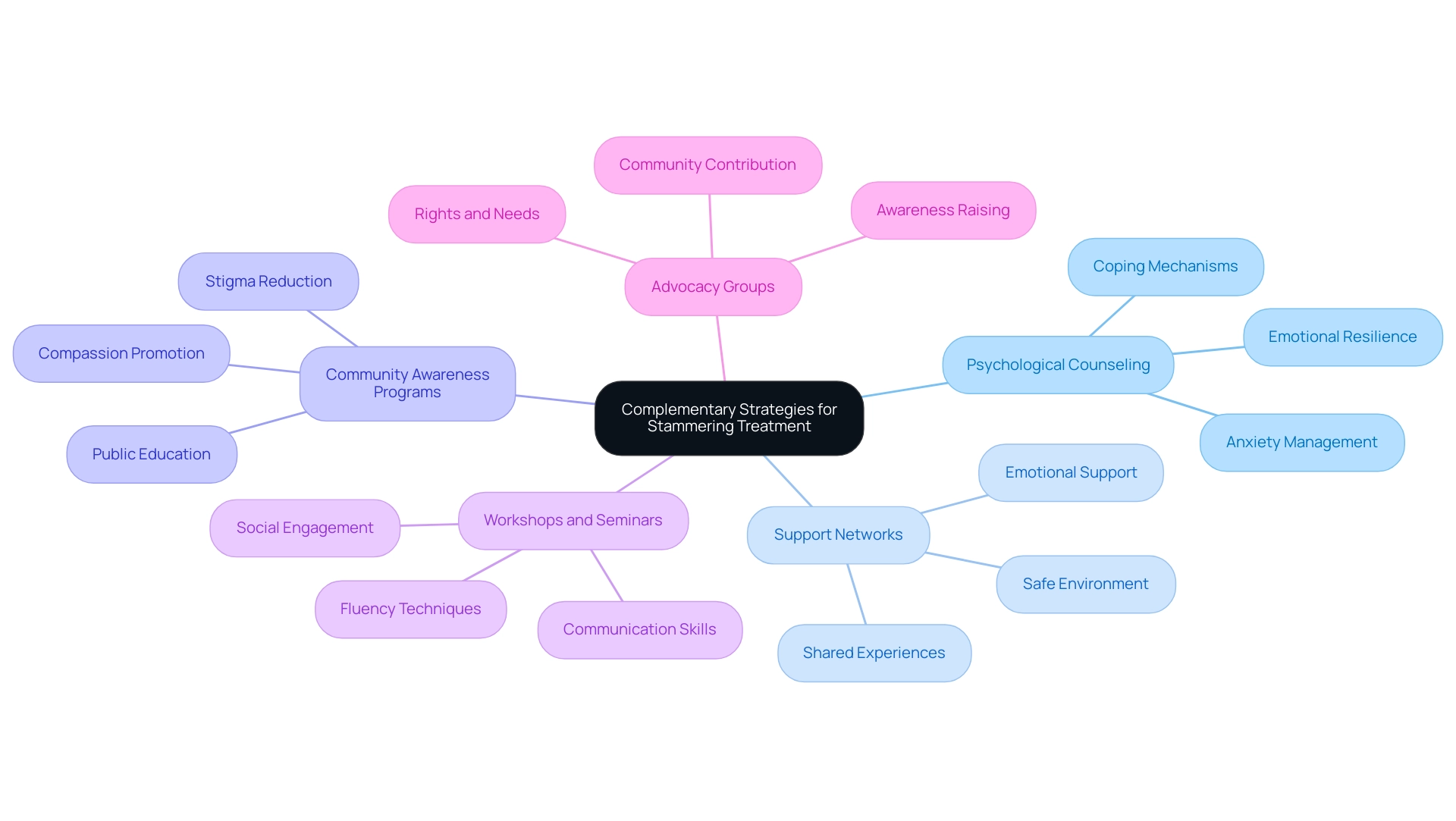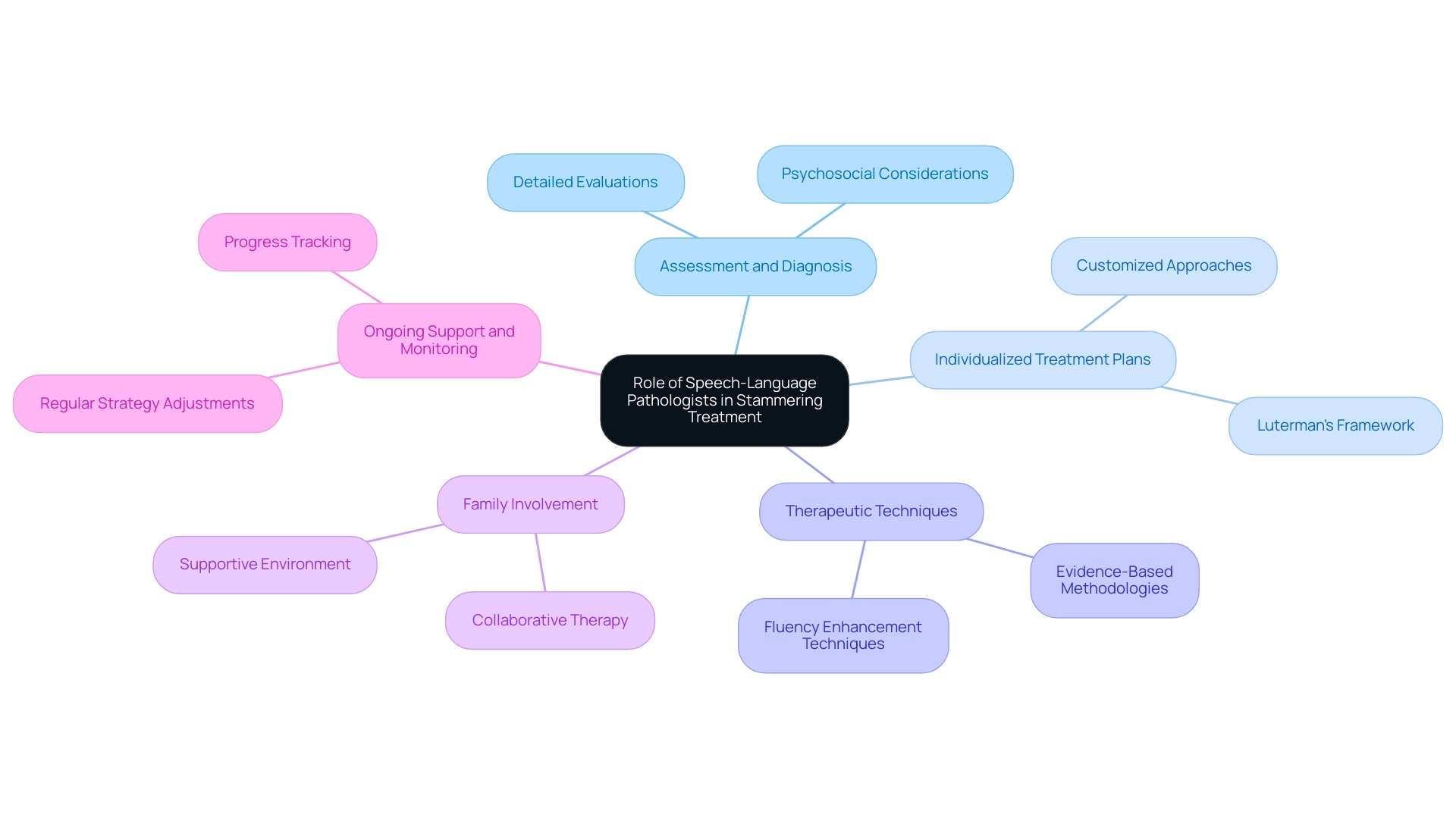Introduction
Stammering, or stuttering, is a complex speech disorder that affects communication and self-esteem for many individuals. With approximately 1.4% of children in the U.S. experiencing voice disorders, understanding the various treatment methods is crucial for those seeking effective solutions.
This article delves into a range of strategies tailored to meet the unique needs of individuals across different age groups, from preschool children to adults. By exploring methods such as:
- Speech therapy
- Cognitive behavioral therapy
- Community support initiatives
insights will be provided into how these approaches can foster improved communication and enhance quality of life. Each treatment option is designed not only to address the symptoms of stammering but also to empower individuals and their families through informed support and ongoing care.
1. Overview of Stammering Treatment Methods
Stammering, also known as stuttering, poses significant challenges to communication and can adversely affect self-esteem. The prevalence of speech disorders is notable, with 1.4% of U.S. children experiencing a voice disorder lasting a week or longer in the past year. Fortunately, a variety of treatment methods, including stammering treatment, exist, each tailored to address the unique needs of people.
Here are some effective strategies:
-
Speech Therapy - Led by licensed speech-language pathologists, this method emphasizes structured exercises and techniques to enhance fluency. Prompt diagnosis and intervention are essential, as shown by case studies emphasizing the positive results of timely stammering treatment and speech therapy, which can greatly enhance expressive skills.
-
Cognitive Behavioral Therapy (CBT) - This psychological method assists people in handling the anxiety frequently linked with stammering, promoting a more relaxed speaking style and improving overall interaction effectiveness.
-
Support Groups - These groups create a supportive environment for individuals to share their experiences and strategies, promoting community understanding and solidarity.
-
Electronic Devices - Certain devices are designed to help regulate speech patterns by providing auditory feedback, which encourages fluent speech delivery.
-
Parent-Child Interaction Therapy - Involving parents in therapy sessions creates a supportive atmosphere for children who stutter, greatly aiding their development and improving family interaction methods.
-
Mindfulness and Relaxation Techniques - Employing these methods can alleviate anxiety and boost overall confidence in expression, enhancing speaking abilities.
-
Educational Programs - Initiatives aimed at raising awareness and understanding of stammering can greatly benefit both individuals who stutter and their broader communities, cultivating empathy and support.
These intervention approaches often focus on
improving vocabulary and guiding family communication methods, while ongoing research continues to explore additional options for stammering treatment. As emphasized by Perez et al., medications like atypical antipsychotics may function as supplementary options for adults, though evidence remains restricted to smaller trials. For more information on stammering intervention methods, inquiries can be directed to Voice: (800) 241-1044, TTY: (800) 241-1055, or email: nidcdinfo@nidcd.nih.gov.
The continual evolution of stammering treatment methods underscores the importance of staying informed about the latest advancements in speech therapy.
2. Effective Treatments for Preschool Children Who Stutter
For preschool children grappling with stuttering, several effective treatment methods have emerged:
-
Parent-Youth Interaction Therapy - This method emphasizes training parents to foster a supportive and relaxed communication atmosphere, enabling young individuals to articulate their thoughts without undue pressure. Research indicates a significant correlation between parental commitment to therapy and improved outcomes in stuttering severity, suggesting that dedicated parental involvement can enhance treatment effectiveness. Notably, a study found that four of the six youngsters significantly reduced stuttering with both parents by the end of the therapy phase, underscoring the importance of family engagement.
-
Play Therapy - Leveraging play as a communication tool can alleviate anxiety associated with speaking. This approach allows young individuals to engage in a non-threatening environment, which can facilitate smoother verbal expression.
-
Fluency Shaping Techniques - These strategies are designed to guide young individuals in speaking slowly and smoothly, ultimately leading to gradual improvements in fluency. The RESTART study has demonstrated that such methods can yield favorable outcomes for many individuals who stutter.
-
Language Enrichment - By promoting rich language experiences through activities like storytelling and interactive reading, parents can significantly enhance their offspring's expressive abilities, providing a solid foundation for effective speech.
-
Modeling Fluent Speech - Parents and caregivers can demonstrate fluent speech patterns, serving as valuable role models for young ones to imitate, thereby reinforcing positive communication habits.
-
Positive Reinforcement - Offering praise for attempts at speaking not only boosts young learners' confidence but also encourages a greater willingness to communicate. This strategy aligns with findings from recent studies, which indicate that positive feedback can substantially impact speech development in young individuals.
The effectiveness of these therapeutic approaches, particularly in stammering treatment, is additionally backed by case studies and expert insights, including a study named "Parental Involvement in Stuttering Care," which emphasized the essential role of parental engagement and its connection with enhancements in stuttering severity among youngsters. Howell, Davis, & Williams observed that the ratio of persistent and recovered family members in both committed and non-committed therapy groups was similar, reinforcing the importance of family support in the therapy process.
3. Tailored Approaches for Older Children and Adults
For older individuals and adults, effective treatment methods encompass a variety of strategies designed to address both the physical and psychological aspects of stammering:
-
Individualized Speech Therapy - Tailored sessions that concentrate on specific speech challenges have been shown to lead to significant improvements in fluency. The success rates for individualized therapy are encouraging, particularly when approaches are adapted to the unique needs of each participant. As a statistical benchmark, expected intelligibility cutoff values for typically developing children indicate that by 47 months, they should reach 100% intelligibility, underscoring the importance of targeted interventions for those who struggle with fluency.
-
Cognitive Behavioral Therapy (CBT) - This therapeutic approach effectively addresses the psychological components of stammering, helping people in managing anxiety and enhancing self-confidence. Success stories illustrate how CBT can empower adults with stuttering to navigate social situations more comfortably.
-
Self-Help Techniques - Encouraging practice in safe environments allows people to gradually improve their fluency. These techniques create a nurturing environment for people to build confidence in their expressive skills.
-
Group Therapy - Facilitated sessions offer a platform for participants to practice speaking within a supportive community. This collaborative environment not only improves interaction abilities but also reduces feelings of isolation commonly associated with stammering.
-
Public Speaking Training - Programs focused on public speaking can help individuals confront their fears directly, improving fluency in high-pressure situations. Such training is vital for building resilience and enhancing overall interaction effectiveness.
-
Mindfulness Practices - Techniques such as meditation and breathing exercises are beneficial in reducing anxiety, which can significantly affect interaction. Mindfulness techniques assist people in staying present and concentrated, ultimately enhancing their speaking skills.
The blend of these methods indicates an increasing acknowledgment of the need for
customized treatment strategies, especially as shown by case studies demonstrating the success of personalized speech therapy for older youth and adults who stutter. For instance, the case study titled 'Combined Speech and Language Interventions' demonstrated that a blend of speech sound and language interventions through telehealth showed promise in improving communication skills, with various approaches customized to participant needs. Furthermore, as noted by Williams (2003b), 'Targets can be maximally distinct from the child's error in terms of place, voice, and manner and can also be maximally different in terms of manner, place of production, and voicing,' reinforcing the importance of individualized strategies.
4. Complementary Strategies: Psychological and Community Support
Effective management of stammering requires complementary strategies in stammering treatment. Key approaches include:
-
Psychological Counseling: Engaging in professional counseling can significantly help people confront the emotional challenges associated with stammering. This support fosters resilience and equips people with coping mechanisms to manage anxiety linked to speaking. For instance, children with severe stuttering often experience significant frustration and embarrassment, which can lead to social anxiety, highlighting the need for tailored psychological support.
-
Support Networks: Forming connections with peers who stutter can offer vital emotional support and share practical coping strategies. These networks create a safe environment for people to express their experiences, thereby alleviating feelings of isolation.
-
Community Awareness Programs: Initiatives designed to reduce stigma and promote understanding of stammering play a crucial role in fostering a supportive environment. Such programs educate the public and encourage compassion towards those who stutter, which can lead to improved social interactions.
-
Workshops and Seminars: Participating in educational programs that focus on enhancing communication skills can empower people, enabling them to engage more confidently in social situations. These workshops often provide practical techniques to improve fluency and manage speaking anxiety. Most people who stutter receive stammering treatment through speech therapy in 60-minute sessions, usually once or twice a week, emphasizing the importance of professional support.
-
Advocacy Groups: Joining organizations that champion the rights and needs of people who stutter can instill a sense of belonging and purpose. Advocacy work not only raises awareness but also creates opportunities for people to contribute to positive change in society perceptions of stuttering.
Incorporating these strategies into stammering treatment plans can enhance the overall effectiveness of stammering management, as evidenced by studies indicating that people who are part of support networks experience lower levels of anxiety and frustration. As highlighted by Guitar and Contour, "Adults who stutter show wide
variation in their degree of frustration with speaking," underscoring the importance of tailored psychological support in their journeys.
5. The Role of Speech-Language Pathologists in Treatment
Speech-language pathologists (SLPs) play a pivotal role in the management of stammering treatment, using a multifaceted approach to assist people effectively. Their responsibilities encompass a range of critical functions:
-
Assessment and Diagnosis - SLPs conduct detailed evaluations to ascertain the specific challenges faced by the individual, which is crucial for effective intervention.
This is particularly important given that severe stuttering can lead to psychosocial issues such as social anxiety, as highlighted in the case study 'Impact of Stuttering on Children.'
-
Individualized Stammering Treatment Plans - By developing customized plans, SLPs address the unique characteristics of each person's stammering, ensuring that the stammering treatment is relevant and effective. Luterman's (2006) insights on counseling individuals with speech disorders provide an authoritative framework for these therapeutic approaches.
-
Therapeutic Techniques - Utilizing evidence-based methodologies, SLPs implement various techniques for stammering treatment aimed at enhancing fluency and communication abilities.
-
Family Involvement - Recognizing the importance of a supportive environment, SLPs often engage family members in the stammering treatment process, fostering a collaborative approach to therapy.
-
Ongoing Support and Monitoring - SLPs provide ongoing support and monitoring in stammering treatment, regularly adjusting strategies to optimize outcomes for individuals as they progress.
Statistically, approximately
1.4% of children in the U.S. experience a voice disorder lasting a week or longer, underscoring the significance of early intervention and the critical role of SLPs in assessment and diagnosis. As emphasized by specialists in the area, a comprehensive evaluation is essential in directing care for stammering treatment, with successful results frequently associated with the proficiency of SLPs in developing customized interventions. Furthermore, as noted by Perez et al., medications, including atypical antipsychotics, might serve as an adjunctive treatment option for adults who stutter, illustrating the importance of a multidisciplinary approach in effective stammering treatment.
Conclusion
Stammering is a significant speech disorder that affects many individuals, impacting their communication abilities and self-esteem. The article highlights a variety of treatment methods available, each tailored to meet the specific needs of individuals, whether they are preschool children, older children, or adults. Key strategies include:
- Speech therapy
- Cognitive behavioral therapy
- Community support initiatives
- Innovative approaches like electronic devices and mindfulness techniques
For preschool children, engaging parents in therapy and utilizing play therapy can yield notable improvements. As children grow older, individualized speech therapy and group sessions become essential for addressing both the physical and psychological aspects of stammering. The inclusion of psychological counseling and support networks is crucial for fostering resilience and managing the emotional challenges associated with stammering.
The role of speech-language pathologists is paramount in this journey, as they provide comprehensive assessments, create customized treatment plans, and involve family members to ensure a supportive environment. The ongoing evolution of treatment methods and the emphasis on community awareness reflect the importance of a holistic approach to stammering, one that empowers individuals and promotes understanding within society.
Ultimately, the journey toward overcoming stammering is multifaceted, requiring a combination of effective treatment strategies, psychological support, and community engagement. By staying informed about the latest advancements and approaches, individuals who stutter can find hope and encouragement on their path to improved communication and self-confidence.
